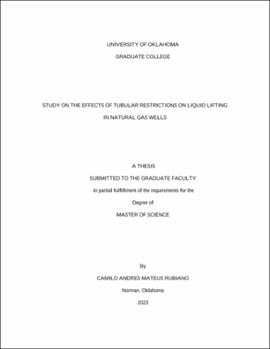| dc.contributor.advisor | Karami Mirazizi, Hamidreza | |
| dc.contributor.author | Mateus Rubiano, Camilo Andres | |
| dc.date.accessioned | 2023-12-14T19:51:27Z | |
| dc.date.available | 2023-12-14T19:51:27Z | |
| dc.date.issued | 2023-12-15 | |
| dc.identifier.uri | https://hdl.handle.net/11244/340048 | |
| dc.description.abstract | Liquid loading is a common issue in natural gas wells, resulting in the accumulation of liquids in the well due to the inability of the gas to carry them to the surface. Various methods have been proposed to identify and address liquid loading, with no optimum solution. Several factors must be taken into account including location, costs and fluid properties. The use of partial tubing restrictions, namely inserts, was proposed about 2 decades ago, yet very limited investigation has been done about it. Most of previous studies have been conducted using only air and water as fluids and have identified that inserts best performance is encountered at low vSL. The present study involves the use of air and oil to evaluate the effectiveness of inserts at a range of conditions from annular to churn-slug flow. The measured parameters are pressure drop, liquid holdup, and video recordings of each test. The test matrix involves over 15 superficial gas velocities and 3 superficial liquid velocities. The effect of insert size and insert spacing is experimentally studied and models reported in the literature are benchmarked. The results suggest that inserts are most effective at low vSL, and in churn flow conditions. Their effects are diminished at low vSg ranges of slug flow and high vSg ranges of annular flow. It was found that the insert size is a relevant parameter in tests involving at least two inserts. The 1.5” insert displays a pronounced positive effect within a narrow vSg range, beyond which negative effects are observed. Tests using 1.75” inserts show a favorable performance for a wider range. The spacing setup with the best performance is obtained by using: 2 inserts, followed by the cases with 1 insert. In the 2-insert configuration, significant improvements are achieved regarding liquid holdup, compared to the cases with a single insert. Also, for this configuration the frictional losses are not substantially increased, in contrast with the tests having three inserts. This method could offer an economical, passive, and effective solution for liquid unloading in gas wells. | en_US |
| dc.language | en | en_US |
| dc.rights | Attribution-NonCommercial-NoDerivatives 4.0 International | * |
| dc.rights.uri | https://creativecommons.org/licenses/by-nc-nd/4.0/ | * |
| dc.subject | Natural gas well | en_US |
| dc.subject | Gas well deliquification | en_US |
| dc.subject | Liquid loading | en_US |
| dc.subject | Two-phase flow | en_US |
| dc.title | Study On The Effects Of Tubular Restrictions On Liquid Lifting In Natural Gas Wells | en_US |
| dc.contributor.committeeMember | Kazempoor, Pejman | |
| dc.contributor.committeeMember | Wu, Xingru | |
| dc.date.manuscript | 2023-12-07 | |
| dc.thesis.degree | Master of Science | en_US |
| ou.group | Mewbourne College of Earth and Energy::Mewbourne School of Petroleum and Geological Engineering | en_US |
| shareok.orcid | 0000-0003-2050-1892 | en_US |
| shareok.nativefileaccess | restricted | en_US |

